Varied difficulty levels in TS Inter 1st Year Zoology Model Papers and TS Inter 1st Year Zoology Question Paper May 2018 cater to students with diverse academic strengths and challenges.
TS Inter 1st Year Zoology Question Paper May 2018
Time: 3 Hours
Max. Marks: 60
General Instructions:
Note : Read the following instructions carefully :
- Answer all the questions in Section – A. Answer any six questions in Section – B and answer any two questions in Section – C.
- In Section – A, questions from Sr. Nos. 1 to 10 are of Very Short Answer Type. Each question carries two marks. Every answer may be limited to 5 lines. Answer all these questions at one place in the same order.
- In Section – B, questions from Sr. Nos. 11 to 18 are of Short Answer Type. Each question carries four marks. Every answer may be limited to 20 lines.
- In Section – C, questions from Sr. Nos. 19 to 21 are Long Answer Type. Each question carries eight marks. Every answer may be limited to 60 lines.
- Draw labelled diagrams wherever necessary for questions in Section – B and C.
Section – A (10 × 2 = 20)
Note : Answer all the questions in 5 lines each.
Question 1.
What is meant by Tautonymy ? Give two examples.
Answer:
The practice of naming the animals or organisms, in which the generic name and species name are the same, is called Tautonymy.
Ex : Axis axis – spotted dear.
Naja naja – The Indian Cobra.
Question 2.
What are Volkmann’s canals ? What is their role ?
Answer:
In compact bone structure the Haversian canals communicate with one another, with the periosteum and also with the marrow cavity by transverse or oblique canals called Volkmann’s canals.
Question 3.
Distinguish between holocrine and apocrine glands.
Answer:
Apocrine glands in which the apical part of the gland cell in pinched off along with the secretory product. Ex: Mammary glands.
Question 4.
What are microglia ? What is their origin ? Add a note on their function.
Answer:
Microglial cells are the Neurogila (supporting cells) of cells of CNS which are phagocytic cells, of mesodermal origin.
![]()
Question 5.
What is the other name for the gill of a mollusc ? What is the function of osphradium ?
Answer:
The other name for the gill of a mollusc is Ctenidia. The main function of Osphradium is to test the purity of water.
Question 6.
Name the four extra embryonic membranes.
Answer:
The extra embryonic membranes namely amnion, allantois, chorion and yolk sac.
Question 7.
How is sexual reproduction advantageous in evolution ?
Answer:
With the sexual reproduction resulting the advantageous in evolution in genetic recombination occurs in sexual reproduction.
Question 8.
What is a kinety ?
Answer:
In the ciliate protozoans a longitudinal row of kinetosomes together with kinetodesmata constitute a unit called kinety.
Question 9.
Describe the methods of biological control of mosquitoes.
Answer:
Introduction of larvivorous fishes, like Gaumbusia, insecti-vorous plants like Utricularia into the places where mosquitoes breed.
Question 10.
What is Meant by interspecific competition ? Give one example.
Answer:
A process in which the fitness of one species is significantly lower in the presence of another species is called interspecific competition.
Ex : Competition between visiting flamingos and resident fishes in shallow South american lakes.
![]()
Section – B (6 × 4 = 24)
Note : Answer any six questions in 20 lines each.
Question 11.
Describe species. Explain the various aspects of species.
Answer:
Species : Species is the ‘basic unit’ of classification. Species is a Latin word meaning ‘kind’ or ‘appearance’. John Ray in his book ‘Historia Generalis Plantarum’ used the term species’ and described it on the basis of common descent (origin from common ancestors) as a group of morphologically similar organisms. Linnaeus considered species, in his book ‘Systema Naturae’, as the basic unit of classification. Buffon, in his book ‘Natural History’, proposed the idea of evolution of species which is the foundation for the biological concept of evolution. This biological concept of species (dynamic nature of species) became more popular with the publication of the book “The Origin qf Species” by Charles Darwin.
Buffon’s biological concept of species explains that species is an interbreeding group of similar individuals sharing the common ‘gene pool’ and producing fertile offspring. Species is considered as a group of individuals which are :
- Reproductively isolated from the individuals of other species – a breeding unit.
- Sharing the same ecological niche – an ecological unit.
- Showing similarity in the karyotype – a genetic unit.
- Having similar structure and functional characteristics – an evolutionary unit.
Question 12.
Describe the structure of cardiac muscle.
Answer:
Cardiac (striped and involuntary) muscle : The cardiac muscle is striated like the skeletal muscle (shows sarcomeres). Cardiac muscle is found in the ‘myocardium’ of the heart of vertebrates. The cardiac muscle cells or the ‘myocardial cells’ are short, cylindrical, mononucleate or binucleate cells whose ends branch and form junctions with other cardiac muscle cells. Each myocardial cells is joined to adjacent myocardial cells by ‘electrical synapses’ or ‘gap junctions’. They permit ‘electrical impulses’ to be conducted along the long axis of the cardiac muscle fibre.
The dark lines across cardiac muscle are called intercalated discs (IDs). These discs are highly characteristic of the cardiac muscle.
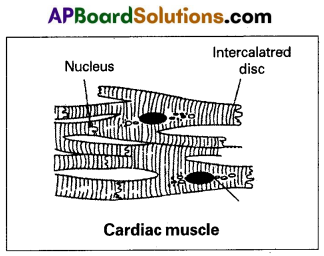
Question 13.
How many types of nephridia occur in Pheretima ? How do you distinguish them ?
Answer:
In Pheretima three types of nephridia are present.
1. Septal nephridia
2. Integumentary nephridia
3. Pharyngeal nephridia.
1. Septal nephridia : The septal nephridia are present on the intersegmental saptum from 15 & 16 segments onwards to last and are opens into alimentary canal.
2. Integumentary nephridia : The integumentary nephridia attached to the inner body wall from the 3rd segment to the last. They open to the exterior on the body surface by nephridiopores.
3. Pharyngial nephridia : The pharyngial nephridia present three paired tufts in the segments 4th, 5th and 6th. They open into the buccal cavity and pharynx.
Question 14.
What are the modifications that are observed in birds that help them in flight ?
Answer:
So many modifications are observed in birds that help them in flight.
- Exo and endo skeletons and body structure features might have contributed for their successful arieal mode of life.
- Exo skeleton consists of epidermal feathers. Feathers are unique to birds. They are useful for flight, particularly the Quill feathers help in flight.
- Body is boat-shaped and streamlined.
- Forelimbs are modified into wings.
- Many bones are neumatic with extensions of air sacs.
- All modern flying birds are provided with powerfull breast muscles (flight muscles) chiefly the pectoralis major and pectoralis minor.
- Lungs are associated with air seas.
Question 15.
Describe the process of transverse binary fission in Paramecium.
Answer:
Transverse binary fission is performed by Paramecium. Binary fission is the most common method of a sexual reproduction in protozoans.
During favourable conditions, Paramecium stops feeding after attaining its maximum growth. At first the micronucleus divides by mitosis and the macronucleus divides into two daughter nuclei by amitosis. The oral groove disappears. After karyokinesis, a transverse constriction appears in the middle of the body, which deepens and divides the parent cell into two daughter individuals,

the anterior proter and the posterior opisthe. The proter receives the anterior contractile vacuole, cytopharynx and cytosome from its parent individual. It develops posterior contractile vacuole and a new oral groove. The opisthe receives the posterior contractile vacuole of its parent. It develops a new anterior contractile vacuole, cytopharynx, cytostome and a new oral groove. Binary fission is completed in almost two hours, in favourable conditions and Paramecium can produce four generations of daughter individuals by binary fission in a day.
The transverse binary fission is also called homothetogenic fission, because the plane of fission is at right angles to the longitudinal axis of the body. As it occurs at right angles to the kineties, it is also called perkinetal fission.
![]()
Question 16.
Explain the pathogenicity of Wuchereria bancrofti in man.
Answer:
Infection causes filarial fever which is characterised by headache, mental depression and increase in the body temperature. In general the infection of filarial worm causes inflammation effect in lymph vessels and lymph glands. Inflammation in the lymph vessels is called lymphangitis and that of lymph glands is called lymphadenitis. In the case of heavy infection, the accumulation of dead worms blocks the lymph vessels and lymph glands resultings in immense swelling of limbs, scrotum of males and mammary glands in females. Fibroblasts accumulate in these tissue and form the fibrous tissue. In severe case, the sweat glands of the skin in the affected region disingtegrate and the skin becomes rough. This terminal condition is called elephantiasis.
Question 17.
Draw a neat labelled diagram of the mouthparts of cockroach.
Answer:
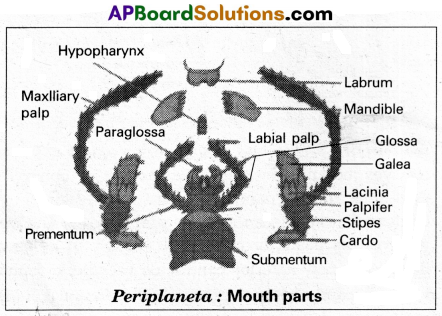
Question 18.
Describe briefly the following:
a) Green house gases
b) Noise pollution
c) Organic farming
d) Muncipal solid wastes
Answer:
a) Green house gases : The Earth’s surface re-emits heat in the form of infrared radiation but part of this does not escape into space as atmospheric gases (e.g. carbon dioxide, methane, etc.) absorb a major fraction of it. The molecules of these gases radiate heat energy, and a major part of which again comes back to the Earth’s surface, thus heating it up once again. The above-mentioned gases- Carbondioxide and methane are commonly known as green house gases.
b) Noise pollution: Undesirably high sounds constitute noise pollution. Sound is measured in units called decibles. The human ear is sensitive to sounds ranging form 0 to 180 db. o db is threshold limit of hearing and 120 db is threshold limit for sensation of pain in the ear. Any noise above 120 db is considered to be a noise pollution. A brief exposure to extremely high sound level. 150 db or more generated by jet planes while taking off may damage eardrums causing permanent hearing impairment. Even long term exposure to a relatively higher level of noise of cities may also cause hearing impair¬ment. Noise also causes auditory fatigue, anxiety, sleeplessness (insomnia), increased heart beat, altered breathing pat¬tern thus causing considerable stress to humans.
c) Organic farming : Integrated organic farming is a zero waste procedure, where recycling of waste products is efficiently carried out. The allows the maximum utilisation of resource and increases the efficiency of production. A method practiced by Ramesh chandra Dagar, all these processes support one another an allow and extremely economical and sustainable venture. Natural – bio – gas generated in the process can be used for meeting the energy needs of the farm. Enthusiastic about spreading information and helping in the practice of integrated organic farming, Dagar has created the Haryana Kisan welfare club.
d) Municipal Solid waste : Anything (substance / material / articles / goods) that is thrown out as waste in solid form is referred to as solid waste. The municipal solid wastes generally consist of paper, food wastes, plastics, glass, metals, rubber, lather, textile etc., The wastes are burnt to reduce the volume of the wastes. As the substitute for open – burning dumps, sanitary landfills are adopted. There is a danger of seepage of chemicals and pollutants from these landfills, which may contaminate the underground water resources.
![]()
Section – C (2 × 8 = 16)
Note : Answer any two questions in 60 lines each.
Question 19.
Describe the life cycle of plasmodium vivax in mosquito with a neat labelled diagram.
Answer:
Life cycle of plasmodium in mosquito (The mosquito phase) Ross cycle :
When a female Anopheles mosquito bites and sucks the blood of a malaria patient the gametocytes along with the other stages of the erythrocytic cycle reach the crop of mosquito. Here all the stages are digested except the gametocytes. Further part of the life cycle consists of
i) Gametogony
ii) Fertilization
iii) Formation of ookinete & oocysts iv) Sporogony.
i) Gametogony : The formation of male and female gametes from the gametocytes is called gametogony. It occurs in the lumen of the crop of mosquito.
Formation of male gametes : During this process the nucleus of microgametocyte divides into eight daughter nuclei called pronuclei which reach the periphery. The cytoplasm is pushed out in the form of eight flagella like processes. Into each flagellum like process one pronucleus enters and forms a micro gamete or male gamete. These male gametes show lashing movements like flagella and get separated from the cytoplasm of microgametocyte. This process is called exflagellation.
Formation of female gamete : The female gametocyte undergoes a few changes and transforms into a female gamete. This process is called maturation. The nucleus of the female gamete moves towards the periphery and the cytoplasm at that point forms a projection. This projected region is called the fertilization cone.
Fertilization : The fusion of male and female gametes is called fertilization. It also occurs in the lumen of the crop of the mosquito. When an actively moving male gamete comes into contact with the fertilization cone of the female gamete, it
enters it, the pronuclei and cytoplasm of these two gametes fuse with each other, resulting in the formation of a synkaryon.
Since the two gametes are dissimilar in size this process is known as anisogomy. The female gamete that bears the synkaryon is called the zygote which is round and non-motile.
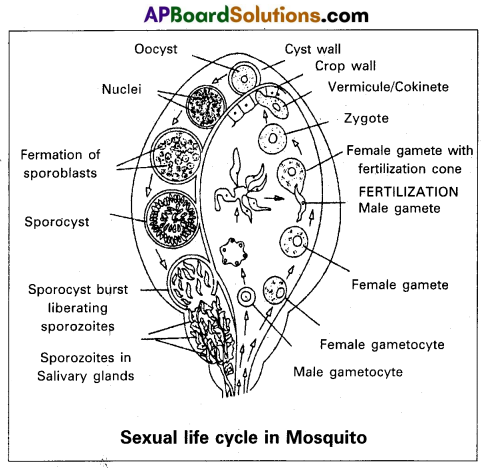
iii) Formation of ookinete and oocysts : The zygote remains inactive for some time and then transforms into a long, slender, motile, vermiform ookinete or vermicule with in 18 to 24 hours. It pierces the wall of the crop and settles beneath the basement membrane. It becomes round and secretes acyst around its body. This encysted ookinete is now called oocyst. About 50 to 500 oocysts are formed on the wall of the crop and appear in the form of small nodules.
iv) Sporogony : The formation of sporozoites in the oocysts is called sporogony. According to Bano, the nucleus of the oocyst first undergoes reduction division followed by repeated mitotic divisions resulting in the formation of about 1,000 daughter nuclei. Each bit of nucleus is surrounded by a little bit of the cytoplasm and transforms into a sickle shaped sporozoite. Oocyst with such sporozoites is called sporocyst.
When this sporocyst reptures, the sprrozoites are liberated into the haemocoel of the mosquito. From there, they travel into the salivary glands and are ready for infection. The life cycle of plasmodium in mosquito completes in about 10 to 24 days.
Question 20.
Describe the digestive system of Cockroach with the help of a neat labelled diagram.
Answer:
The digestive system of cockroach consists of an alimentary canal and the associated glands. The preoral cavity surrounded by the mouth parts, is present in front of the mouth. The hypo- pharynx divides it into two chambers called cibagium (anterior) and salivarium (posterior).
Alimentary canal : The alimentary canal of cockroach is a long tube and is coiled at some places. It extends between the mouth and the anus. It is divided into three regions namely foregut of stomodaeum, midgut or mesenteron and hindgut are internally lined by ectoderm. The mesenteron is lined by the endodermal cells.
Forgutodaeum : The foregut includes pharynx oesophagus, rop and gizzard. It is internally lined by a chitinous cuticle. Mouth opens into the pharynx, which in turn leads into a narrow tubular oesophagus. The oesophagus opens behind into a thin walled distensible sac called crop. The crop serves as a reservoir for storing food. Its outer surface is covered by a network of tracheae. Behind the crop there is a thick walled muscular proven- triculus or gizzard. The chitinous inner living of the gizzard has six powerful teeth, which form an efficient grinding apparatus. Behind each tooth is a hairy pad, which bears backwardly directed bristles. Among these plates, food is throughly ground into fine particles. These food particles are filtered by the bristles. The gizzard thus acts both as a grinding mill and also as a sieve. There is a membranous projection of the gizzard into the mesenteron in the form of a funnel called stomodeal valve. This valve prevents the entry (regurgitation) of food from the mesenteron back into the gizzard.

Midgut (mesenteron or ventriculus) : The midgut is a short and narrow tube behind the gizzard. It is also called mesenteron or ventriculus. Between the ventriculus and the gizzard, arising from ventriculus there are six to eighth finger like diverticule called hepatic caecae.
They are helpful in digestion and absorption of the digested food materials. Ventriculus is functionally divided into an anterior secretory part and a posterior absorptive part.
The secretory part of the ventriculus has many gland cells and it secretes several enzymes. The ‘bolus’ of food in the mesenteron is enveloped by a chitinous and porous membrane called peritrophic membrane, which is secreted by the funnel like stomodeal valve of the gizzard. Digested food is absorbed into the food through the peritrophic membrane in the posterior absorptive region of the ventriculus. The peritrophic membrane protects the wall of the ventriculus from hard food particles in the food. The opening of the ventriculus into the hindgut is controlled by a sphincture muscle. It prevents entry of undigested food and uric from the hindgut into the midgut.
Hindgut or proctodaeum: The hindgut is a long coiled tube, consisting of three regions namely ileum, colon and rectum. It is internally lined by chitinous cuticle. The ileum that lies behind the mesenteron is a short tube. Six bundles of fine yellow, blind tubules called Malpighian tubules open into the ileum near the junction of mesenteron and ileum. Malpighian tubules are excretory in function. Ileum collects uric acid from the malpighian tubules and undigested food from the mesenteron. Ileum opens behind into a long coiled tube called colon. Colon leads into a short and wide rectum which opens out through the anus. Rectum bears on its inner side six longitudinal chitinous folds called rectal papillae. They are concerned with the reabsorption of water from the undigested food.
Digestive gland : The digestive glands associated with the alimentary canal of cockroach are salivary glands, hepatic caecae and glandular cells of the mesenteron.

Salivary glands : There is a pair of salivary glands attached to the vetrolateral sides of the crop, one on each side. Each salivary gland has two lobes. Each lobe of salivary gland has many lobules called acini. Each acinus is a group of secretory cells called zymogen cells with a small ductule. The ductules of both the lobes of a salivary gland unite to form a common salivary duct on each side.
The two common salivary ducts are joined to form the median salivary duct. Between the two lobes of a salivary gland of each side is a sac called salivary receptacular duct or common reservoir duct. The midious salivary duct opens into the common receptacular duct. Later these two form an efferent salivaryduct. The efferent salivary duct opens at the base of the hypopharynx. Acinar cells secrete saliva, which contains starch digesting enzymes such as amylase.
Hepatic caecae : The hepatic caecae are also termed midguts caecae. They contain secretory and absorptive cells.
Glandular cells of the mesenteron : The glandular cells of the mesenteron secrete enzymes such as maltase, invertase, proteases and lipase.
![]()
Question 21.
Describe the different types of food chains that exist in an ecosystem.
Answer:
The food energy passes from one trophic level to another trophic level mostly from the lower to higher trophic levels. When the path of food energy is linear’ the components resemble the links’ of a chain and it is called ‘food chain’. Generally a food chain ends with decomposers. The three major types of food chains in an ecosystem are Grazing Food Chain, Parasitic Food Chain and Detritus Food Chain.
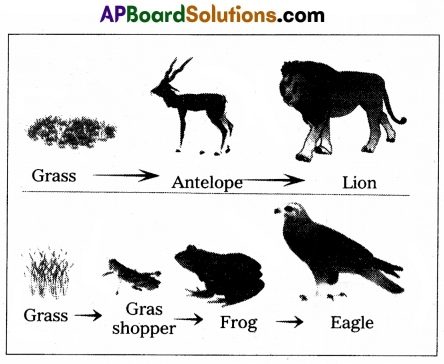
i) Grazing food chain : It is also known as predatory food chain, it begins with the green plants (producers) and the second third and fourth trophic levels are occupied by the herbivores, primary carnivores and secondary carnivores respectively. In some food chains these is yet another trophic level – the climax carnivores. The number of trophic levels in food chains varies form 3 to 5 generally. Some examples from grazing food chain (GFC) are given below.
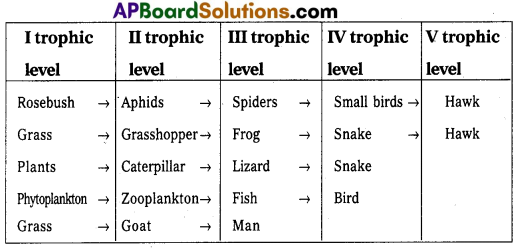
ii) Parasitic food chain : Some authors included the Parasitic Food Chains as a part of the GFC. As in the case of GFCs, it also begins with the producers, the plants (directly or indirectly). However, the food energy passes from large organisms to small organisms in the parasitic chains. For instance, a tree which occupies the 1st trophic level provides shelter and food for many birds. These birds host many ectoparasites and endo parasites. Thus, unlike in the predator food chain, the path of the flow of energy includes fewer, large sized organisms in the lower trophic levels and numerous, small sized organisms in the successive higher trophic levels.
iii) Detritus Food Chain : The detritus food chain (DFC) begins with dead organic matter (such as leaf litter, bodies of dead organisms). It is made up of decomposers which are heterotrophic organisms, mainly the ‘fungi’ and ‘bacteria’. They meet their energy and nutrient requirements by degrading dead organic matter or detritus. These are also known as saprotrophs (sapro : to decompose).
Decomposers : Secrete digestive enzymes that breakdown dead and waste materials (such as faeces) into simple absorbable substances. Some examples of detritus food chains are:
- Detritus (formed from leaf litter) – Earthworms – Frogs – Snakes
- Dead animals – Flies and maggots – Frogs – Snakes.
In an aquatic ecosystem, GFC is the major conduit1 for the energy flow. As against this in a terrestrial ecosystem, a much larger fraction of energy flows through the detritus food chain than through the GFC. Detritus food chain may be connected with the grazing food chain at some levels. Some of the organisms of DFC may form the prey of the GFC animals. For example, in the detritus food chain given above, the earthworms of the DFC may become the food of the birds of the GFC. It is to be understood that food chains are not ‘isolated’ always.